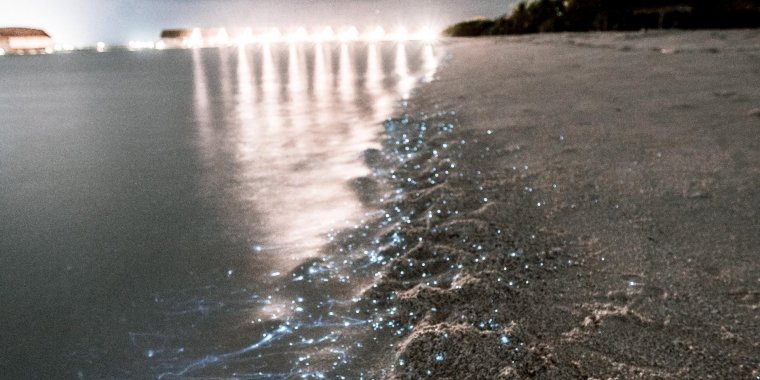| News / Science News |
How single-celled organisms light up the oceans
Every few years, a bloom of microscopic organisms called dinoflagellates transforms the coasts around the world by endowing breaking waves with an eerie blue glow. This year’s spectacular bloom in southern California was a particularly striking example. In a new study, researchers have identified the underlying physics that results in light production in one species of these organisms.

Flashes bright when squeezed tight: how single-celled organisms light up the oceans. Photo: Kevin Wolf/Unsplash
The international team, led by the University of Cambridge, developed unique experimental tools based on micromanipulation and high-speed imaging to visualise light production on the single-cell level.
They showed how a single-celled organism of the species Pyrocystis lunula produces a flash of light when its cell wall is deformed by mechanical forces.
Through systematic experimentation, they found that the brightness of the flash depends both on the depth of the deformation and the rate at which it is imposed.
Known as a ‘viscoelastic’ response, this behaviour is found in many complex materials such as fluids with suspended polymers.
In the case of organisms like Pyrocystis lunula, known as dinoflagellates, this mechanism is most likely related to ion channels, which are specialised proteins distributed on the cell membrane.
When the membrane is stressed, these channels open up, allowing calcium to move between compartments in the cell, triggering a biochemical cascade that produces light.
“Despite decades of scientific research, primarily within the field of biochemistry, the physical mechanism by which fluid flow triggers light production has remained unclear,” said Professor Raymond E. Goldstein, the Schlumberger Professor of Complex Physical Systems in the Department of Applied Mathematics and Theoretical Physics, who led the research.
Bioluminescence has been of interest to humankind for thousands of years, as it is visible as the glow of night-time breaking waves in the ocean or the spark of fireflies in the forest.
Many authors and philosophers have written about bioluminescence, from Aristotle to Shakespeare, who in Hamlet wrote about the ‘uneffectual fire’ of the glow-worm; a reference to production of light without heat.
The bioluminescence in the ocean is, however, not ‘uneffectual.’ In contrast, it is used for defence, offense, and mating. In the case of dinoflagellates, they use light production to scare off predators.
The results of the current study show that when the deformation of the cell wall is small, the light intensity is small no matter how rapidly the indentation is made, and it is also small when the indentation is large but applied slowly. Only when both the amplitude and rate are large is the light intensity maximised.
The group developed a mathematical model that was able to explain these observations quantitatively, and they suggest that this behaviour can act as a filter to avoid spurious light flashes from being triggered. (University of Cambridge)
YOU MAY ALSO LIKE





